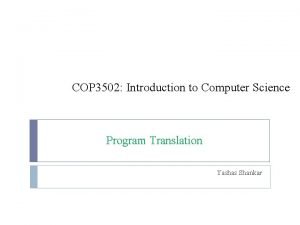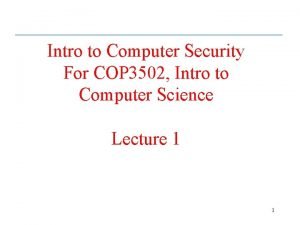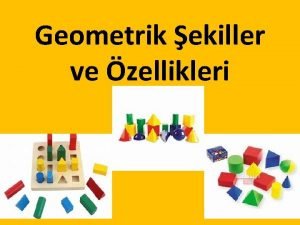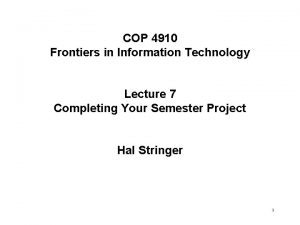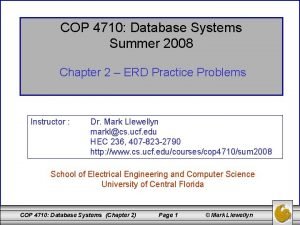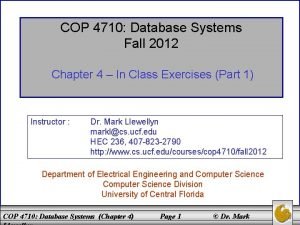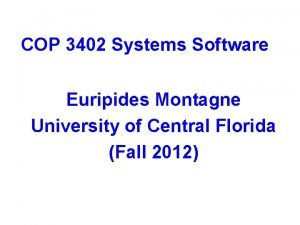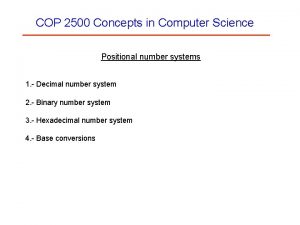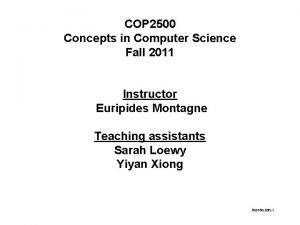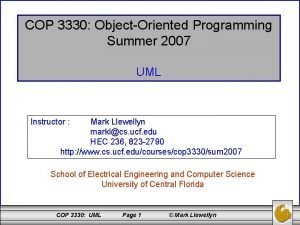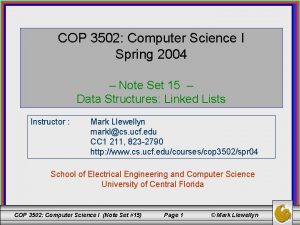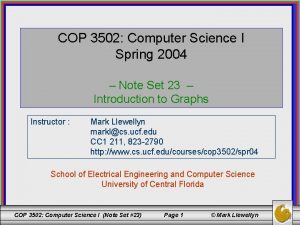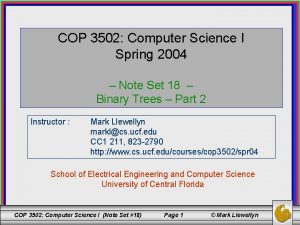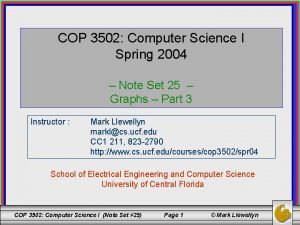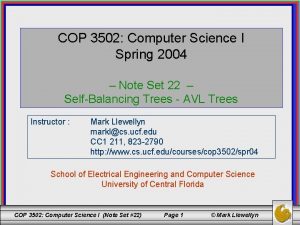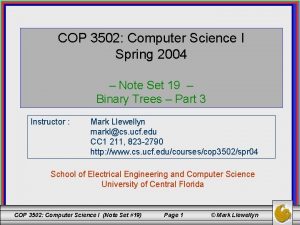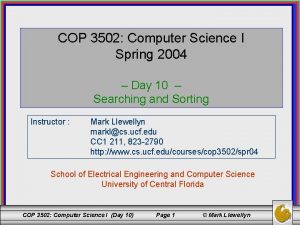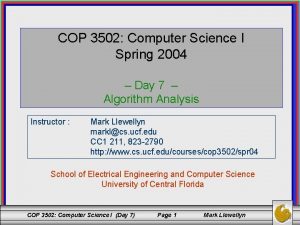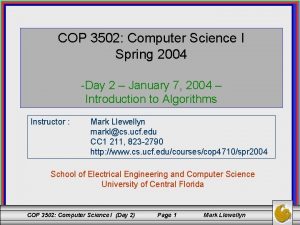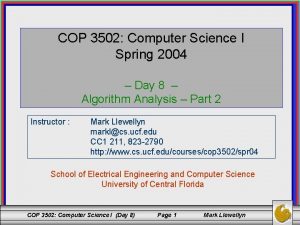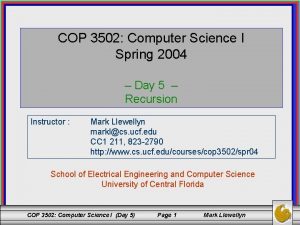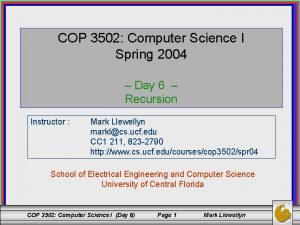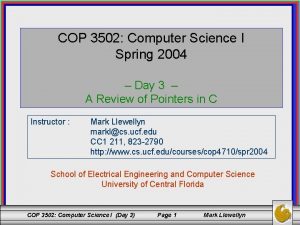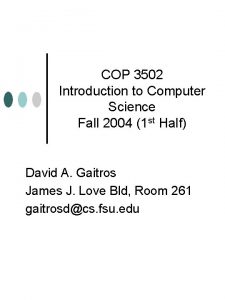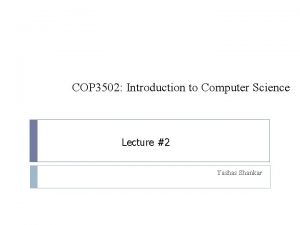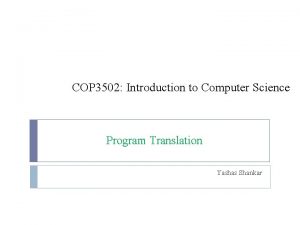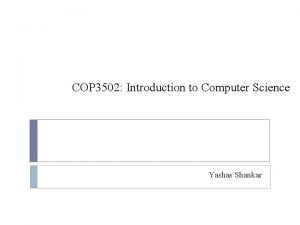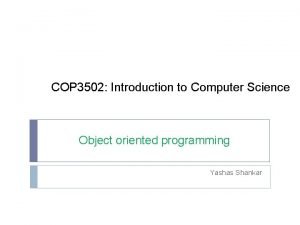COP 3502 Computer Science I Spring 2004 Note









![An Algorithm For Constructing A Balanced BST void balance( int data[], int first, int An Algorithm For Constructing A Balanced BST void balance( int data[], int first, int](https://slidetodoc.com/presentation_image_h2/7fda0ec1c6d49ece30f9d33aac7eb157/image-10.jpg)



























- Slides: 37

COP 3502: Computer Science I Spring 2004 – Note Set 21 – Balancing Binary Trees Instructor : Mark Llewellyn markl@cs. ucf. edu CC 1 211, 823 -2790 http: //www. cs. ucf. edu/courses/cop 3502/spr 04 School of Electrical Engineering and Computer Science University of Central Florida COP 3502: Computer Science I (Note Set #21) Page 1 © Mark Llewellyn

The Need to Balance Binary Search Trees • As we mentioned previously, the run-time of our search algorithm (also insertion and deletion algorithms) is highly dependent on the balance of the BST being searched. • If the data from which a BST is to be built arrives in sorted order, the resulting tree will be a right skewed tree that will resemble a linear list. The resulting search time will be O(n) rather than the O(log 2 n) that should be expected. – • If the data arrives in reverse sorted order the resulting tree will be left skewed. Since the run-time of our algorithms is dependent on the structure property of the BST as well as the ordering property, we need to be sure that the BST is as short and fat as possible rather than tall and skinny. COP 3502: Computer Science I (Note Set #21) Page 2 © Mark Llewellyn

A Right-Skewed Binary Search Tree 13 16 18 20 22 24 25 26 28 COP 3502: Computer Science I (Note Set #21) Page 3 © Mark Llewellyn

A Left-Skewed Binary Search Tree 18 16 14 12 10 8 6 4 2 COP 3502: Computer Science I (Note Set #21) Page 4 © Mark Llewellyn

An Un-balanced Binary Search Tree 26 29 13 An unbalanced BST This tree is also leftskewed. 24 10 8 22 20 18 16 COP 3502: Computer Science I (Note Set #21) 28 25 The number of potential nodes to be searched for values less than 26 is 9 while the number of potential nodes to be searched for values greater than 26 is 2. Height of left subtree is 7, but height of right subtree is 3. Page 5 © Mark Llewellyn

Balancing Binary Search Trees • What we need to do is take an un-balanced BST and balance the tree at each subtree level and maintain the search tree ordering property in the process. 13 18 16 transform into 18 13 20 22 16 20 22 Balanced BST Un-balanced BST COP 3502: Computer Science I (Note Set #21) Page 6 © Mark Llewellyn

Balancing Binary Search Trees (cont. ) • A binary tree is height balanced (or simply balanced), if the height of the two subtrees of any node in the tree differs by at most 1. Stated another way, a binary tree is balanced if the difference in height of the subtrees of any node is either 0 or 1. • A binary tree is perfectly balanced if it is balanced and all of the leaf nodes of the tree are found on one or two levels of the tree. • For example, a perfectly balanced binary tree consisting of 10, 000 nodes, the height of this tree will be log(10, 001) = 13. 289 = 14. In practical terms, this means that if 10, 000 elements are stored in a perfectly balanced tree, then at most 14 nodes will need to be checked to locate a specific element. This is a substantial difference when compared to the worst case of 10, 000 elements in a list! Therefore, in trees which are to be used primarily for searching, it is worth the effort to either build the tree so that it is balanced or modify the existing tree so that it is balanced. COP 3502: Computer Science I (Note Set #21) Page 7 © Mark Llewellyn

Balancing Binary Search Trees (cont. ) • There a number of techniques that have been developed to balance binary trees. Some of the techniques consist of constantly restructuring the tree when elements arrive and lead to a balanced tree. Some of them consist of reordering the data and then build the tree according to some ordering of the data which will ensure that the tree is balanced when it is constructed. • As we saw earlier, if the data which is used to construct a BST arrives in either ascending or descending order the tree will be skewed to the point of representing a linear list. Thus, if the smallest value in the data set is the first value read, the root of the tree will contain only a right subtree. Similarly, if the largest value in the data set is entered first, the root of the tree will contain only a left subtree. Before looking at more sophisticated algorithms to balance binary trees, lets examine a very simple technique to construct a balanced BST. COP 3502: Computer Science I (Note Set #21) Page 8 © Mark Llewellyn

Constructing A Balanced BST • When the data arrive, store all of them into an array. Once all the data have arrived, sort the array using an efficient sorting algorithm. • Once sorted, the element at the midpoint of the array will become the root of the BST. The array can now be viewed as consisting of two subarrays, one to the left of the midpoint and one to the right of the midpoint. • The middle element in the left subarray becomes the left child of the root node and the middle element in the right subarray becomes the right child of the root. • This process continues with further subdivision of the original array until all the elements in the array have been positioned in the BST. • A slight modification of this would be to completely generate the left subtree of the root before generating the right subtree of the root. If this is done, then the very simple recursive procedure shown on the next slide can be used to generate a balanced BST. COP 3502: Computer Science I (Note Set #21) Page 9 © Mark Llewellyn
![An Algorithm For Constructing A Balanced BST void balance int data int first int An Algorithm For Constructing A Balanced BST void balance( int data[], int first, int](https://slidetodoc.com/presentation_image_h2/7fda0ec1c6d49ece30f9d33aac7eb157/image-10.jpg)
An Algorithm For Constructing A Balanced BST void balance( int data[], int first, int last) { if (first <= last) { int middle = (first + last)/2; //find middle element in the array insert(data[middle]); //add node to the tree balance(data, first, middle-1); balance(data, middle+1, last); } } An example of the execution of this algorithm is shown on the next slide. COP 3502: Computer Science I (Note Set #21) Page 10 © Mark Llewellyn

Example - Constructing A Balanced BST Stream of arriving data: 5, 1, 9, 8, 7, 0, 2, 3, 4, 6 Array of sorted data: 0, 1, 2, 3, 4, 5, 6, 7, 8, 9 Construct left side of BST first. (a) 0 1 2 3 4 5 6 7 8 9 (b) 0 1 2 3 4 5 6 7 8 9 4 Resulting BST: 1 (c) 0 1 2 3 4 5 6 7 8 9 4 Resulting BST: 1 0 COP 3502: Computer Science I (Note Set #21) Page 11 2 © Mark Llewellyn

Example - Constructing A Balanced BST (d) 0 1 2 3 4 5 6 7 8 9 (cont. ) 4 Resulting BST: After completing this step, the left side of the BST is completely constructed. 1 0 2 3 Now construct right side of BST (e) 0 1 2 3 4 5 6 7 8 9 4 Resulting BST: 1 0 7 2 3 COP 3502: Computer Science I (Note Set #21) Page 12 © Mark Llewellyn

Example - Constructing A Balanced BST (f) 0 1 2 3 4 5 6 7 8 4 Resulting BST: 9 1 7 0 (g) 0 1 2 3 4 5 6 The numbers shown outside of each node represent the difference in height of the left and right subtrees of that node. Notice that all of these values are either 0 or 1 indicating that the tree is balanced. This tree also happens to be perfectly balanced. 7 8 2 5 3 9 Final BST: COP 3502: Computer Science I (Note Set #21) 0 0 4 1 0 (cont. ) 7 1 2 5 1 3 0 Page 13 0 8 1 6 0 1 9 0 © Mark Llewellyn 8

Problems with the Previous Algorithm • While the previous algorithm for constructing a balanced binary search tree is certainly simple, it has one serious drawback: all the data must be put into an array before the balanced tree can be created. • This algorithm will not work when the tree must be in use before all of the data have arrived. • Can you think of a way to create a balanced tree from an existing unbalanced tree without requiring the data to be sorted as this algorithm requires? – One way to do it would be to read the data from an unbalanced tree into an array using an inorder traversal of the tree. The unbalanced tree could then be destroyed and a new one created from the data in the array using the previous algorithm. In this fashion, no sort is required to put the data into order! COP 3502: Computer Science I (Note Set #21) Page 14 © Mark Llewellyn

Balancing Existing BSTs • While the previous algorithm was certainly simple, it was basically inefficient in that an additional array was required which typically required sorting before the balanced tree could be created. To avoid the sorting, required deconstructing an existing unbalanced tree and reconstructing the tree, which is quite inefficient except for very small trees (in which case their unbalanced nature is probably not a hindrance in any case). • There are however, several algorithms which require very little additional storage for intermediate variables and use no sorting procedure. The DSW algorithm, developed by Colin Day and later improved by Quentin Stout and Bette Warren, is a very elegant algorithm which falls into this category. This is the algorithm we will examine. COP 3502: Computer Science I (Note Set #21) Page 15 © Mark Llewellyn

Balancing Existing BSTs (cont. ) • The basic building block for tree transformations in the DSW algorithm is the rotation. • There are two types of rotations, left rotations and right rotations, which are symmetric to one another. • The rotation of a tree occurs about its root. • The rotation algorithms that we will look at will use the following notation to identify nodes in a tree. The node Ch identifies a child node, the node Par identifies a nodes parent and the node Gr identifies a nodes grandparent. • In the rotations that we will examine, a rotation always rotates a child about its parent. Left children rotate to the right about the parent and right children rotate to the left about the parent. COP 3502: Computer Science I (Note Set #21) Page 16 © Mark Llewellyn

Right Rotations Gr Gr Ch Par S S Par Ch R P P Q Q Tree after right rotation Tree before right rotation occurs COP 3502: Computer Science I (Note Set #21) Page 17 © Mark Llewellyn R

Right Rotation - Example 14 1 0 14 19 2 16 15 1 20 18 0 16 2 15 19 17 18 Tree before right rotation of 16 about 19 occurs Right rotation causes 16 to slide up the tree to the right and 19 to slide down the tree to the right. COP 3502: Computer Science I (Note Set #21) 17 Tree after right rotation of 16 about 19 has occurred. Notice that the resulting tree is still a BST. Page 18 © Mark Llewellyn 20

Right Rotation Algorithm //rotate Ch about Par, Gr is grandparent of Ch, Par is parent of Ch rotate. Right (Gr, Par, Ch) if Par is not the root of the tree //i. e. , Gr is not null grandparent Gr of child Ch becomes Ch’s parent by replacing Par; right subtree of Ch becomes left subtree of Ch’s parent Par; node Ch acquires Par as its right child; COP 3502: Computer Science I (Note Set #21) Page 19 © Mark Llewellyn

Left Rotations Gr Gr Ch Par S S Par Ch R P Q P R Tree after left rotation Tree before left rotation occurs COP 3502: Computer Science I (Note Set #21) Q Page 20 © Mark Llewellyn

Left Rotation - Example 24 10 6 24 35 15 12 28 18 14 COP 3502: Computer Science I (Note Set #21) 18 10 6 28 12 Tree before right rotation of 15 about 10 occurs Left rotation causes 15 to slide up the tree to the left and 10 to slide down the tree to the left. 35 15 40 14 Tree after right rotation of 15 about 10 has occurred. Notice that the resulting tree is still a BST. Page 21 © Mark Llewellyn 40

Left Rotation Algorithm //rotate Ch about Par, Gr is grandparent of Ch, Par is parent of Ch rotate. Left (Gr, Par, Ch) if Par is not the root of the tree //i. e. , Gr is not null grandparent Gr of child Ch becomes Ch’s parent by replacing Par; left subtree of Ch becomes right subtree of Ch’s parent Par; node Ch acquires Par as its left child; COP 3502: Computer Science I (Note Set #21) Page 22 © Mark Llewellyn

The DSW Algorithm • The DSW algorithm is a two-step algorithm which results in a perfectly balanced tree. • The first step takes an unbalanced BST and converts the tree into a backbone (sometimes called a vine). The backbone is simply an ordered linear list of the nodes that comprise the BST. • The second step of the algorithm converts the backbone into a perfectly balanced tree by performing a series of rotations about the root of the tree. The total number of rotations that are performed is a function of the number of nodes in the tree and the resulting height of a complete tree consisting of the number of nodes in the tree. COP 3502: Computer Science I (Note Set #21) Page 23 © Mark Llewellyn

Step #1 of the DSW Algorithm Creating the Backbone //Create a backbone (vine) from an unbalanced BST create. Backbone (root, n) { tmp = root; while (tmp != null) if tmp has a left child rotate this child about tmp; //this is a right rotation set tmp to the child which just became the parent; else set tmp to its right child; } An example illustrating this part of the DSW algorithm begins on the next page COP 3502: Computer Science I (Note Set #21) Page 24 © Mark Llewellyn

Creating the Backbone 5 tmp 5 10 10 20 20 30 15 25 23 30 15 40 25 28 1. Initial unbalanced BST COP 3502: Computer Science I (Note Set #21) 23 2. 40 28 First location of tmp. At this node, tmp has no left child, so it simply advances down the tree (to the right). Page 25 © Mark Llewellyn

Creating the Backbone 5 (cont. ) 4. 5 10 tmp 20 25 23 10 15 30 15 Backbone after right rotation of 15 about 20. 20 40 30 28 25 2. Location of tmp at first node with a left child. The left child of this node is right rotated about tmp. COP 3502: Computer Science I (Note Set #21) 23 Page 26 40 28 © Mark Llewellyn

Creating the Backbone 5 (cont. ) 5 6. 10 10 15 Backbone after right rotation of 25 about 30. 15 20 20 tmp 25 30 25 23 5. 23 40 30 28 28 Next location of tmp where a left child exists. COP 3502: Computer Science I (Note Set #21) Page 27 © Mark Llewellyn 40

Creating the Backbone 7. 5 Notice that tmp has not moved and yet after the previous rotation, still has a left child so another rotation about the same node (with value 25 now) occurs. (cont. ) 5 8. 10 Tree after rotating 23 about 25. 15 10 20 15 23 tmp 20 25 25 30 23 30 28 28 40 COP 3502: Computer Science I (Note Set #21) Page 28 © Mark Llewellyn 40

Creating the Backbone 5 (cont. ) 5 9. 10 Final location of tmp with a left child. Will cause right rotation of 28 about 30. 10 15 15 20 20 23 23 tmp 25 25 28 30 40 10. COP 3502: Computer Science I (Note Set #21) Final backbone. Page 29 © Mark Llewellyn 40

Analysis of Step 1 of the DSW Algorithm • Since performing a rotation requires knowledge about the parent of tmp, an additional reference must be maintained when the algorithm is implemented. • In the best case, the tree is already a backbone (i. e. , totally right skewed) and the while loop of the algorithm will execute n times and no rotations are performed. • In the worst case, when the root does not have a right child, the while loop will be executed 2 n-1 times and n-1 rotations will be performed, where n is the number of nodes in the tree. • Thus, the run time of the first phase of the DSW algorithm is O(n). COP 3502: Computer Science I (Note Set #21) Page 30 © Mark Llewellyn

Step #2 of the DSW Algorithm • In the second phase, the backbone is transformed into a tree, but this time the tree will be perfectly balanced by having leaves only on two adjacent levels. • In each pass down the backbone, every second node is rotated about its parent. • One such pass decreases the size of the backbone by one-half. • Only the first pass may not reach the end of the backbone. It is used to account for the difference between the number n of nodes in the current tree and the number 2 lg(n+1) -1 of nodes in the closest complete binary tree. Thus, overflowing nodes are treated separately. • The core (step 2) of the DSW algorithm is shown on the next slide. COP 3502: Computer Science I (Note Set #21) Page 31 © Mark Llewellyn

Step #2 of the DSW Algorithm Creating a Perfectly Balanced BST create. Perfect. Tree(n) m = 2 lg(n+1) -1; //n is the number of nodes in the backbone //perform initial rotations – these are left rotations make n-m rotations starting from the top of the backbone; //perform remainder of necessary left rotations while (m > 1) m = m/2; make m rotations starting from the top of the backbone; An example illustrating the second part of the DSW algorithm begins on the next page COP 3502: Computer Science I (Note Set #21) Page 32 © Mark Llewellyn

Creating the BST From the Backbone 5 10 10 15 20 15 23 23 25 25 1. Initial backbone. Value of n is 9. Value of m is 7 since, 2 lg(n+1) -1 = 2 lg(9+1) -1 = 23 -1 = 7. Thus, n -m = 9 -7 = 2, so 2 initial rotations are made. 28 28 2. 30 40 COP 3502: Computer Science I (Note Set #21) BST/backbone after first two (n-m) initial rotations are completed. Page 33 30 © Mark Llewellyn 40

Creating the BST From the Backbone 10 20 20 5 15 10 23 5 23 15 25 25 28 28 3. (cont. ) Initially the value of m is 7. Upon entering the while loop the value of m is reset to 3 (7/2 = 3). So 3 more rotations are made. These rotated nodes are highlighted. 30 40 COP 3502: Computer Science I (Note Set #21) After performing the first of the three rotations indicated in step 3. Rotation of 20 about 10. Page 34 © Mark Llewellyn 40

Creating the BST From the Backbone 20 20 10 5 15 (cont. ) 25 23 10 28 5 15 30 25 23 30 28 40 40 5. After performing the second of the three rotations indicated in step 3. Rotation of 25 about 23. COP 3502: Computer Science I (Note Set #21) 6. After performing the third of the three rotations indicated in step 3. Rotation of 30 about 28. Page 35 © Mark Llewellyn

Creating the BST From the Backbone (cont. ) 20 25 10 25 20 5 15 23 30 10 28 40 5 7. 30 Re-entering the while loop again resets the value of m from 3 to 1 (3/2 = 1). So one more rotation is performed. Rotating 25 about 20. COP 3502: Computer Science I (Note Set #21) 8. 23 28 15 After performing the last rotation of 25 about 20. The resulting BST is perfectly balanced. Page 36 © Mark Llewellyn 40

Analysis of Step 2 of the DSW Algorithm • To compute the complexity of the tree building phase, note that the number of iterations performed by the while loop equals: • The number of rotations can now be given by the expression: • Thus, the number of rotations is O(n). Because creating a backbone also required at most O(n) rotations, the cost of global rebalancing with the DSW algorithm is optimal in terms of time because it grows linearly with n and requires a very small and fixed amount of storage. COP 3502: Computer Science I (Note Set #21) Page 37 © Mark Llewellyn
 Cop3502
Cop3502 Cop 3502
Cop 3502 Cop 3502c
Cop 3502c Good cop bad cop interrogation
Good cop bad cop interrogation Cop 1 cop 2
Cop 1 cop 2 Kim ki duk summer fall winter spring
Kim ki duk summer fall winter spring Spring summer autumn winter dates
Spring summer autumn winter dates Difference between note making and note taking
Difference between note making and note taking Whats signal words
Whats signal words Difference between note making and note taking
Difference between note making and note taking Goods received note vs delivery note
Goods received note vs delivery note Draw a specimen of debit note
Draw a specimen of debit note How to write debit note
How to write debit note Relevance of note making
Relevance of note making Loan x has a principal of $10 000x
Loan x has a principal of $10 000x What s your favourite subject
What s your favourite subject Refrigerant cop
Refrigerant cop Air cycle refrigeration
Air cycle refrigeration Isppia
Isppia Objectives of air conditioning system
Objectives of air conditioning system üçgen prizma hangi nesnelere benzer
üçgen prizma hangi nesnelere benzer Pollycop
Pollycop Cop 4910
Cop 4910 Cop 4710
Cop 4710 Cop 4710 ucf
Cop 4710 ucf Cop 3402
Cop 3402 Cop 2500
Cop 2500 Cop 2500
Cop 2500 Anima assoclima
Anima assoclima What is computer memory
What is computer memory Brooklyn cop analysis
Brooklyn cop analysis Audit cop
Audit cop Cop 16
Cop 16 Snow cop
Snow cop Cop 5725
Cop 5725 Ron eaglin
Ron eaglin Cop 3330 ucf
Cop 3330 ucf Cop 3014 fsu
Cop 3014 fsu
